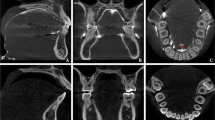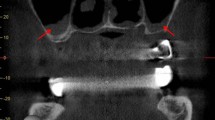Abstract
When imaged, intraoral chewing gum has the potential to be misdiagnosed. Chewing gum has a characteristic appearance on CT: it is ovoid in shape, hyperdense, and has small internal locules of air. Reports have described the appearance of gum on radiographs and abdominal CT images; however, no reports could be found detailing its appearance within the mouth. This report describes the appearance of intraoral chewing gum as well as the properties of the gum that lead to this appearance. Because of the potential for misdiagnosis, screening for intraoral foreign bodies should be considered prior to imaging.



Similar content being viewed by others
References
Geller E, Smergel EM (1992) Bubble gum simulating abdominal calcifications. Pediatr Radiol 22:298–299
Truex JH, Silberman TL, Wood BP (1989) Radiological case of the month. Bubble gum bezoar. Am J Dis Child 143:253–254
Wm. Wrigley Jr. Company (2008) Ingredient and nutrition information. Wm. Wrigley Jr. Company, Peoria, IL. http://www.wrigley.com/wrigley/products/products_nutritional.asp. Accessed 4 August 2008
Cadbury Adams USA (2008) Trident products. Cadbury Adams USA, Parsippany, NJ. http://www.tridentgum.com/#/products. Accessed 4 August 2008
Wikipedia (2008) Gum base. Wikipedia Foundation, San Francisco, CA. http://en.wikipedia.org/wiki/Gum_base. Accessed 4 August 2008
Jain RK, Rich FM (1988) Gum-simulating tumor. Oral Surg Oral Med Oral Pathol 66:268
Kawabe J, Higashiyama S, Okamura T et al (2003) FDG uptake by tongue and muscles of mastication reflecting increased metabolic activity of muscles after chewing gum. Clin Nucl Med 28:220–221
Vock J, Juengling FD, Krause T et al (2007) Muscular FDG uptake after chewing chewing gum in a patient with Hodgkin disease. Clin Nucl Med 32:124–127
Author information
Authors and Affiliations
Corresponding author
Rights and permissions
About this article
Cite this article
Towbin, A.J. The CT appearance of intraoral chewing gum. Pediatr Radiol 38, 1350–1352 (2008). https://doi.org/10.1007/s00247-008-0980-0
Received:
Revised:
Accepted:
Published:
Issue Date:
DOI: https://doi.org/10.1007/s00247-008-0980-0




